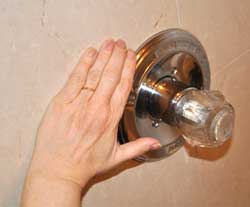 A hot shower is one of my favorite things in the morning, but last week I was scared to take my hot shower because I'd gotten burned the day before, turning on the hot water!
A hot shower is one of my favorite things in the morning, but last week I was scared to take my hot shower because I'd gotten burned the day before, turning on the hot water!
We weren't home. We were in New York City having rented an apartment for a week as I had some workshops and love visiting New York during the Christmas holidays. Being a frequent traveler (in Moscow, you could only get hot water during published hours), I know to check the faucet before turning the water on and that's where the problem started.
If you're curious, the photo shows my burned hand (size of a small egg below my 3 middle fingers) wrapped around the shower faucet. If you believe the arrows, you're supposed to turn the shower handle to the left for “more” hot water. The problem was when turning the faucet to the right for cold water, it was actually hot enough (guessing at least 150°) to burn my hand in just 1 to 2 seconds, the time it took to pull my hand away!
How Quickly a Hot Shower or Bath Can Burn
It takes almost no time for an adult to be seriously burned by water that's too hot, i.e. my hot shower story. Like others who don't think it will happen to them or a loved one, I now have a better appreciation for how scary it can be. I finished my hot shower although it was painful for any water to touch the burned skin. After getting dressed, I looked up burns online to see what I needed to do. Don't laugh too hard as I stuck my left hand in a pot of cold water next to my computer, so I could get to work. After an hour I dried my hand, put some cream on the burn and took some Ibuprofen!
Fortunately I pulled my hand away fast enough that I didn't need to visit an emergency room but not everyone is so lucky. Each year there are roughly 3,800 injuries and 34 deaths in homes due to scalding from excessively hot tap water. Most of these accidents involve children under five and the elderly. Their skin is more sensitive and they can be burned with even shorter exposure times than the table below. That's why the US Consumer Product Safety Commission (CPSC) urges everyone to lower their water heaters to 120° Fahrenheit, to insure we don't burn ourselves turning on a hot shower or sink faucet.
There's an added bonus — by lowering your hot water temperature, you'll conserve energy and save money.
| Water Temperature Setting | Exposure Time | Effects of Exposure to Hot Water at High Temperatures |
| Hot water at 100°F below | Most water heaters won't scald an adult occupant but can scald babies, young children & seniors | |
| Hot water at 120°F | 5 minutes | 2nd & 3rd degree burns on adult skin |
| Hot water at 130°F | 30 seconds | 2nd & 3rd degree burns on adult skin |
| Hot water at 140°F | 5 seconds | 2nd & 3rd degree burns on adult skin |
| Hot water at 150°F | 1.5 seconds | 2nd & 3rd degree burns on adult skin |
| Hot water at 160°F | 0.5 second | 2nd & 3rd degree burns on adult skin |
Hot Shower Safety Features
In addition to lowering your hot water heater's temperature, a number of safety devices have been developed to help prevent burns from hot water. Some of these features, meant to prevent a burn like my hot shower story:
- Anti-scald valves – protect you from sudden bursts of scalding or freezing water when a toilet is flushed or the dishwasher starts, while you're talking a nice hot shower.
- Pressure-balancing valves – maintain your preset water temperature when there's a sudden drop in hot or cold water pressure.
- Thermostatic valves – monitor water temperature, adjusting the flow of hot and cold water to maintain a preset temperature (does this sound like the perfect hot shower?). They require an up-front investment and some models include a digital display.
- Anti-scald protection – is now built directly into some faucets, and is definitely a good idea for hot shower and bath faucets.




Leave a Reply